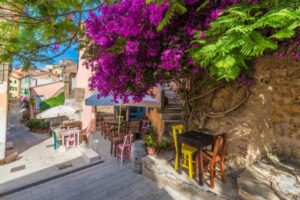THE ISLAND OF ELBA – MORE THAN JUST MEMORIES OF NAPOLEON
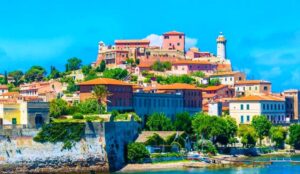
Best known for being the place of Napoleon’s exile in 1814, Elba is the biggest island of the Tuscan archipelago and Italy’s third-largest island, after Sardinia and Sicily. It’s also part of the Arcipelago Toscano National Park. It has so much to offer: there are pretty beaches, good diving, charming towns, dramatic historic fortresses and great food. Lying less than 10 kms from the mainland, it’s easily accessed by a frequent and efficient ferry service from the mainland town of Piombino, as well as its own airport. Elba is a true natural paradise, with crystal clear turquoise waters, green landscapes and hills, plus beautiful flora and fauna, all surrounded by well-preserved coral reefs.
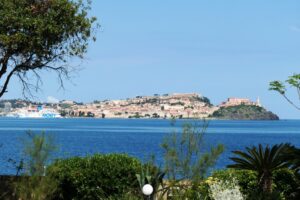
It’s known that the island of Elba was originally inhabited by Ligures Ilvates, who gave it the name Ilva. It was well known for its iron resources and mines, which attracted invasions by the Etruscans and later, the Romans, who left vestiges of their presence. Aristotle tells us that the Greeks called it Aethalia, “smoky”, after the fumes of the smelting furnaces.
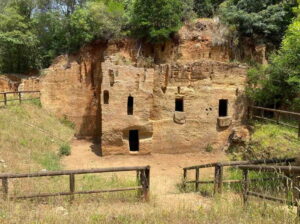
The writer Apollonius of Rhodes mentions the island in his epic poem Argonautica, describing how the Argonauts rested here during their travels. Apollonius writes that signs of their visit were still visible in his day, including skin-coloured pebbles that they dried their hands on, and large stones which they used for discus-throwing. The island was then settled by the Etruscans, who started mining iron at Elba, and later, after 480 BCE, by the Romans, who referred to the island as Ilva. As well as mining iron ore, the Romans established a naval base on the island.
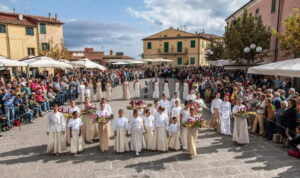
In the early medieval period, Elba was invaded by the Ostrogoths and the Lombards, and later became a possession of the Republic of Pisa. The island went back and forth between the Republics of Pisa and Genoa as they fought for possession, before finally being regained by Pisa in 1292. The island was retained by the Appiani family, the Dukes of Piombino, until 1399 when they sold Pisa to the house of Visconti of Milan.
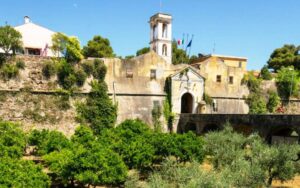
In 1544, Barbary pirates from North Africa devastated Elba and along the coast of Tuscany. Part of the island was later ceded to Cosimo I de Medici, Grand Duke of Tuscany in 1546, who fortified Portoferraio and renamed it “Cosmopoli”. The rest of the island was captured by Philip II of Spain in 1596, who built two fortresses at Porto Longone. The sovereignty of this part of Elba was claimed by the Kingdom of Naples in 1736, but remained abandoned. The British landed on Elba in 1796, after the occupation of Livorno by French Republican troops, to protect the 4,000 French royalists who had found asylum in Portoferraio two years earlier. In 1801 the Peace of Luneville gave Elba to the Kingdom of Etruria, and a year later the island was transferred to France by the Peace of Amiens.
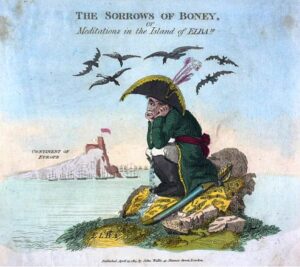
The French Emperor Napoleon was exiled to Elba after his forced abdication following the Treaty of Fontainebleau, and was transported there by the British on HMS Undaunted, arriving at Portoferraio on 04 May 1814. He was allowed to keep a personal guard of 400 men and was nominally sovereign of Elba, although the sea around the island was patrolled by the French and British navies.
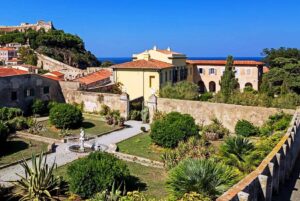
The humiliation of abdication and exile would not have been lost on the former master of all Europe, now reduced to being the nominal monarch of a relatively obscure island. He was surrounded by the faded trappings of Court ceremony, while the pension promised to him did not materialise. He wrote again and again to his wife Marie Louise, the daughter of the Austrian emperor, asking her to join him, or if she could not or would not, to send their infant son. Neither request was granted, as although he didn’t know it, his letters were intercepted by his wife’s family and never reached her. However, despite these distractions, Napoleon carried out a series of economic and social reforms to improve the quality of life for the islanders.
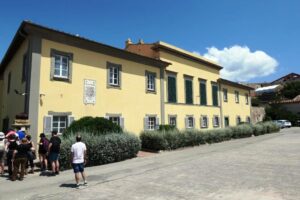
After staying for barely ten months, Napoleon escaped to France on 26 February 1815, landing on the coast of Golfe-Juan near Cannes, accompanied by a small band of 1,100 loyal soldiers.
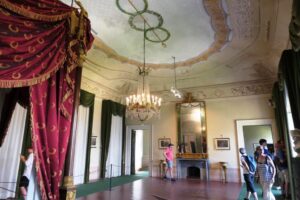
Napoleon’s residence on Elba was the former Palazzina dei Mulini. Built in 1724 by the Grand Duke Gian Gastone de’Medici, compared to his former magnificent palaces in Paris, Versailles and Fontainebleau, it’s a relatively modest villa. Napoleon had some alterations done by the architect Paolo Bargigli from Livorno to suit his own needs better, including the central section of the villa connecting the two original buildings was made higher so that he could have a ballroom.
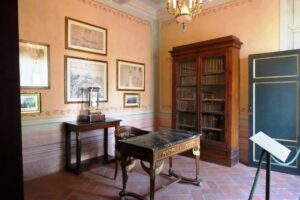
The original furniture that Napoleon’s sister Elisa Baciochi had brought from his residence in Piombino no longer exists, but beautiful 19th century imperial-style furniture has brought the true imperial atmosphere back to life. The library, on the other hand, still has the most important Napoleonic material: the books that the Emperor brought with him from the libraries in Fontainebleau and those that his uncle, Cardinal Fesch, gave to him.
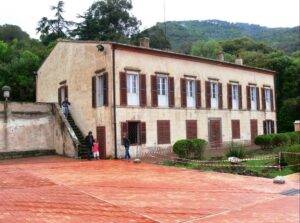
Palazzina dei Mulini is now one of two residences on Elba known as the National Museum of Napoleonic Residences. The other is the Villa San Martino, Napoleon’s elegant summer residence, which he had converted from a large farmhouse, located in the heart of the countryside, about 5 kms south west from Portoferraio.
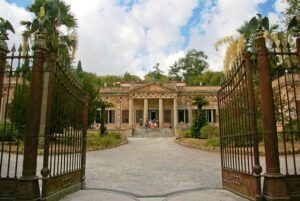
The current presentation of the villa, built in Neo Classical style, was the work of Count Anatolio Demidoff, husband of Napoleon’s niece Matilde di Monfort. In 1851, he decided to upgrade the Napoleonic building to create a residence worthy of Imperial pomp and grandeur, and suitable to show off his antiques collection and Napoleonic memorabilia.
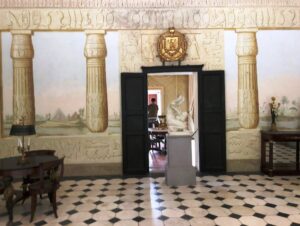
At the entrance is a beautiful sculpture by the Italian artist Canova of Galatea, the legendary statue come to life from Ovid’s poem Metamorphoses. Napoleon’s sister, Paolina was Canova’s model. The ground floor is now the Demidoff Gallery. The Napoleonic apartments are above this. The reception rooms are lavishly decorated with frescoes by Vincenzo Antonio Revilli from Turin. On the upper floor is the Egyptian room, where an octagonal tank inset into the floor has papyrus plants, with trompe l’oeil on the walls representing the Egyptian countryside, and an elegant dining room decorated with lovers’ knots on the ceiling. There are a few original pieces of furniture from Napoleon’s time. It’s not a particularly lavish residence, and perhaps its main attraction is its historical connection to one of history’s most controversial and influential figures.
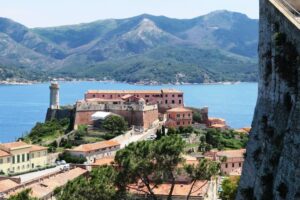
Back in Portoferraio, a visit to the two forts that dominate the headland is a must. As mentioned, the Palazzina dei Mulini lies adjacent to salmon-pink Fort Stella. Together with Fort Falcone and the Torre del Linguella, also called the Torre del Martello, they formed the main defensive system built by Cosimo de’Medici in 1548. The star-shaped Fort Stella rises on a promontory 49m above the sea, from where the entire bay of Portoferraio could be controlled. The panoramic vista from the Fort is truly spectacular.

This impressive structure is surrounded by imposing walls clad in brick. The entire complex is full of numerous passages and underground areas, which in the past were sometimes used as emergency shelters during enemy attacks. At the top of the fortress there are five corner bastions, part of which still conserves the original watchtower sentry posts. The fort once housed the bronze bust of Cosimo I de’Medici by Benvenuto Cellini, which was removed by the Grand Duke Pietro Leopoldo, who moved it to Florence, where it is still in the Museo del Bargello.
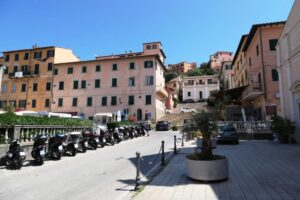
Portoferraio’s highest hill is crowned by the largely intact 16th century Fort Falcone. To get there, from Piazzale Napoleone head uphill along via del Falcone to the winding path that leads up to the fort.
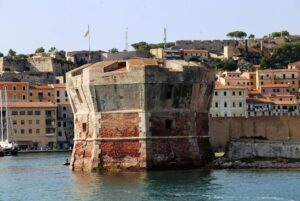
As soon as you arrive in Portoferraio, you can’t help but see the Torre del Linguella, in a prominent position at the mouth of the yacht harbour, but also due to its octagonal shape. In the beginning, it was used as a watchtower, then became a storeroom for salt, then for the cleaning and preparation of tuna fish, and in the 18th century, the Grand Dukes of Lorena had it turned into a prison. After lying for years in a state of total neglect, renovation work was carried out in 1977, and it was during these extensive works that the remains of a once-lavish Roman villa were revealed.
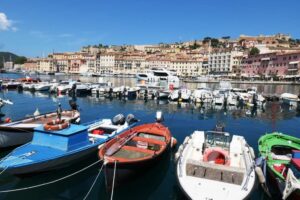
The old harbour is now lined with attractive 3 storey residences, a hotel and waterfront shops and restaurants that sweep up the sloping terrain below the two forts. A delightful area to stroll as you progress upwards via sets of dramatic staircases and steep streets from the harbour towards the forts above. You will pass the very pleasant Piazza della Repubblica and fine churches and outdoor cafes, where you could try the local beer, named after their most famous short-term resident.
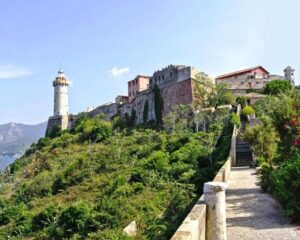
On the north-east summit stands the historic lighthouse of Portoferraio, which was built by the Grand Duke Leopold of Lorraine in 1788 in the place that, up until then, only had a lamp to signal the location of the promontory situated behind the natural harbour of Portoferraio. The historian Sebastiano Lombardi called it the most beautiful and majestic lighthouse in the Mediterranean. The complex is made up of several buildings which were once the powder magazine, armory, deposit warehouses, hospital and recuperation facilities, as well as a small chapel that served as a place of worship for the sentries who guarded the fort.
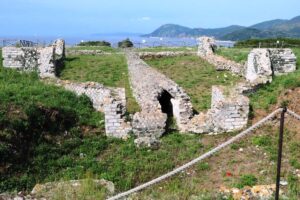
Dating back to the 1st century BCE, the Roman Villa in Le Grotte is only one of three such villas discovered on Elba that had not undergone a process of rebuilding over the centuries. It had been left and forgotten by the end of the 1st century AD. Excavations between 1960 and 1972 revealed the full structure of the villa. It had been a large and palatial complex. Surrounded by a peristyle, it had 3 large gardens and enjoyed a magnificent view over the gulf of Portoferraio. Today, visitors can see remains of frescoes on walls, thermal baths with a caldarium and frigidarium, and below, a small jetty built in granite for those who arrived by sea. The seals on some amphoras and doliums (large, round terracotta containers used for transporting wine) were also found, with inscriptions on them bearing the name of the owner, Marcus Valerio Messalla, of the ancient Valeri family. This is also borne out by the writings of Ovid in which he declares that this ancient villa on the island of Elba belonged to the Valeri family. The villa is located on a headland about 5kms out of Portoferraio.
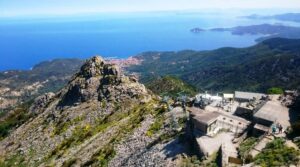
If you love hiking, you can head up to the peak of Monte Capanne, the highest point of the island at 1,019 m. above sea level. Walking along the footpaths that lead to the peak you will discover the beautiful Mediterranean plant life and forests, which has its own unique scent. Several animals can be seen here, and you might catch sight of wild boars or mouflons—a wild sheep native to Cyprus—which were brought to Elba by a private landowner in the 1960s, kept in a reserve until the owner abandoned the facility, and who now roam free. There is also a small cable car to the summit of Monte Capanne that departs from Marciana. However you get there, you will be rewarded by a stunning 360 degree panorama over the entire island and the Tuscan Archipelago.
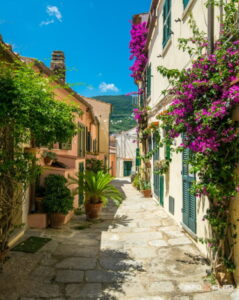
There are numerous postcard-perfect villages and much more to see and do on Elba. Don’t forget to investigate the famed thermal baths, found in a thermal basin on the Portoferraio Gulf. They are said to be rich in iron and iodine, which are known to help soothe aching muscles and joints. Accommodation is good quality, nothing too overwhelming and many smaller resorts to choose from. Some are located on lovely sandy beaches, and set in pleasant grounds with pools, perfect for relaxing.
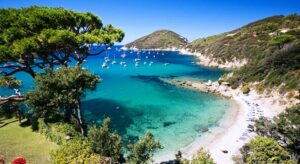
Elba is renowned in Europe as one of the most beautiful places for snorkelling. The sea beds are extremely rich in fish and marine flora. Expect to see eels, groupers, blue fish and starfish, as well as the rare sunfish and red coral.

Needless to say, seafood features predominantly in the local cuisine. The most popular dishes area those that require long and complicated preparation, and one such favourite is stockfish with potatoes. Another favourite is Gurguglione, which is a mixture of local vegetables, such as peppers, eggplants, zucchini and tomatoes. You will also find octopus, small fried fish and stuffed sardines on many menus, all flavoured with local herbs and spices.
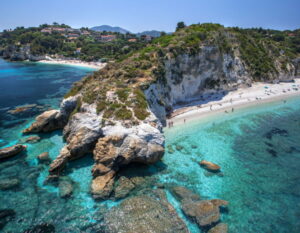
Chestnut trees have been grown on the island’s verdant mountain slopes since the late 14th century, and chestnuts, either fresh, dried or ground to chestnut flour, have been a fundamental part of the local diet for centuries. There are many interesting species of mushrooms found on Elba that feature in local cuisine, and the island produces many different flavours and varieties of honey. The local Elba wines are first class and many bear the DOC appellation. The local Aleatico DOCG red wine has been made on the island for centuries.
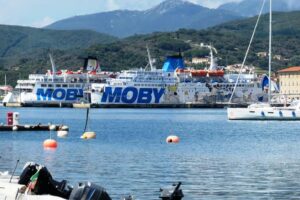
So, if you think you’ve already seen most of Italy, expand your horizons and think about adding Elba to your next Italian adventure. It’s easy to get to, has its own distinct character and a wide variety of attractions to satisfy most visitors.
